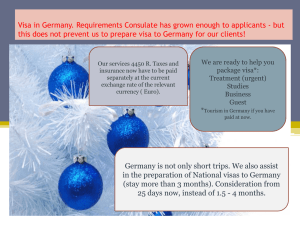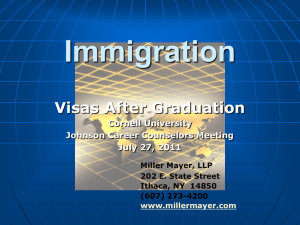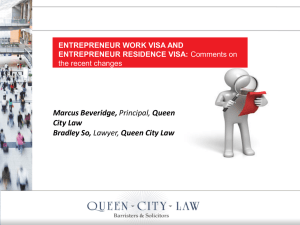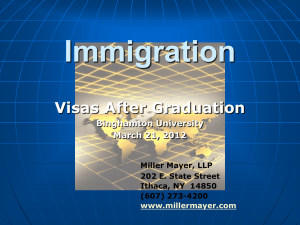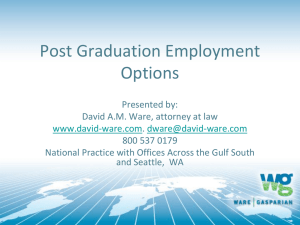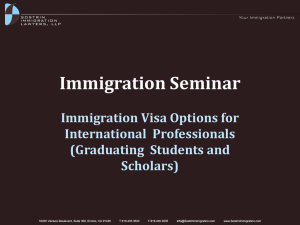limitations - Utah Nursery and Landscape Association
advertisement
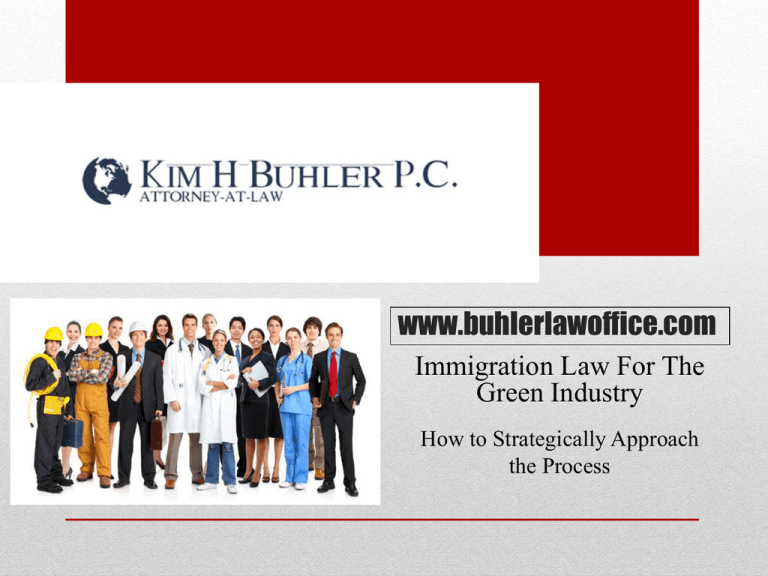
www.buhlerlawoffice.com Immigration Law For The Green Industry How to Strategically Approach the Process Work Authorization Options for Foreign Workers The Basics The Visa • What is a Visa? • Official endorsement from the U.S. Department of State granting eligibility for admission to the U.S. • Who Needs a Visa? • A citizen of a foreign country who plans to enter the U.S. for a specific purpose. • What Does a Visa Look Like? • It is a stamp placed in the passport by the U.S. Consulate/Embassy abroad. Non-Immigrant vs. Immigrant • Temporary Purpose Non-Immigrant • - Temporary work or study visas (H-1B, TN, F-1) • Permanent Residence Immigrant Visa • - “Green card” Non-Immigrant Visas Include, but are not limited to: • H1B Specialty Occupation (Landscape Architects) • F1 Student Visa/Optional Practical Training (OPT) (Landscape Management, Construction Management) • TN (Treaty NAFTA – Canada/Mexico) • L1 Intra-Company Transfers (Start Your Own Landscape Company in the US if you Have One Abroad) • E1/E2 Treaty Trader/Investor (Transferring from a Landscape Company Abroad to one in the US) • E3 Specialty Occupation (Australia) (Same as H1b Visa Abroad) • H2B Seasonal Non-Agricultural Workers Basic Application Process for All Visas Except H2Bs Employer decides to hire a non-U.S. worker Documents and information gathered (job, candidate, and company) Attorneys review information and prepare case Attorney submits to appropriate government agency Final Attorney Review Employer reviews case and approves to proceed Receipt issued by government that case has been received Time required by government to review case and adjudicate Case approved by government and approval notice issued Who Can You Employ? • U.S. Citizen Can Work for Any Employer Can Only Work for Certain Employer(s) • Green Card Holder (Lawful Permanent Resident) • Work Permit Holder (green card applicants, spouses of E, J, or L visa holders, students in post-graduate training) • Student visa holders with authorization to work off-campus (F, M, or J students) • Seasonal Temporary Workers (H-2A, H-2B) • Professional Visas (H-1B, E, L, TN) • Student visa holders without authorization to work off-campus (F, M, or J students) Cannot Work for Anyone • Spouses of certain visa holders (H-4, F-2, TD) • Tourists (B-1, B-2, VWP) • Those who stayed longer than permitted or entered U.S. illegally and have no other status pending Work Visas 101 The H1B Temporary Work Visa The theoretical and practical application of a body of highly specialized knowledge. H1B Options for Landscapers • • • • • Landscape Architects. Construction Management. Land Surveyor. Horticulturalist. Any other position where the obtainment of a bachelors degree is required to perform the duties of the position. What is an H1B Visa? • • • • • • A temporary nonimmigrant work visa – 85,000 issued annually Allows foreign nationals with a bachelor’s degree or higher to enter the U.S. on a temporary basis to work for a U.S. employer Obtain a change of status (COS) in the US; or at a U.S. Consulate/Embassy abroad Good for an initial period of 3 years; possible extension for an additional 3 years (total of 6 yrs.) Employer specific visa: Work authorization granted only for the employer named in the visa. U.S. degree or foreign equivalent degree through education/work experience. How Do You Obtain a H1B Visa? • • • • • File an application for the employee. Show that the position requires a bachelor’s degree in a specialized area and that the beneficiary has the requisite bachelor’s degree for the position. Employers must first satisfy Department of Labor wage standards. Pay the necessary filing fees. - Initial government cost for filing an H1B visa: $2,325 initial filing fee; $1,575 if your company has less than 25 employees. - Company must pay $1,500, or $750, of the fees. Cannot deduct $ from employee’s pay check to pay company back. Can premium process for additional $1,225 – this gets you a decision on your case in 15 days. Create Public Access File. What Do You Have to Prove? • • • • • • Applicant has graduated and has earned a degree. Must have a specialty degree and a job that requires that specialty related to major, not minor degree. Some fields don’t work. Nature of the specific duties are so specialized and complex that knowledge required to perform the duties is usually associated with attainment of a bachelor’s degree or higher. The job description must be very specific in job duties. If you can do the duties without a specialized degree, the position doesn’t qualify. Show that other employees with the same position within the industry have the same or similar degree (i.e. Chemist, Teacher etc.). A Bachelor’s Degree equivalency is allowed if you have a full 4-year degree. Can use work experience and foreign education. Must get certified evaluation. I suggest www.wes.org or www.jsilney.com (3 for 1 rule.) H1B Cap – Once They’re Gone, They’re Gone! Congress regulates the number of H1B visas that are issued each year based on a Fiscal Year (FY) system – October 1 to October 1. • Limited to 65,000 visas a year. We can begin applying on April 1, 2013 for October 1, 2013 start date. A lottery may be held due to high rate of applications received. In 2008, 166,000 people applied for the 65,000 visas on the first day. Visas ran out in 1 week. In 2012, visas ran out midJune. The lottery is based on the dates the applications are received; not first come first served. • 20,000 extra visas given to foreigners with U.S. Master’s or Ph.D. Degrees. • Only “new” H1B’s are subject to the cap. Extensions or transfers to new employers are not subject to the cap, and can be filed at any point in time. • Universities and non-profit organizations affiliated with a university are not subject to the cap. (Risky though – subject to higher scrutiny.) • Earliest date to file H1B petition is six months prior to the start date of employment. • Obtaining approval for H1B status can take 3 to 6 months. Sample of Approval Notice: H1B’s Have Run Out & FN Has No Degree. What Other Options Are There? • • • • • • F1 Student Visa/Optional Practical Training (OPT) TN (Treaty NAFTA – Canada/Mexico) L1 Intra-Company Transfers E1/E2 Treaty Trader/Investor E3 Specialty Occupation (Australia) H2B Temporary/Seasonal Non-Agricultural Workers Is the Foreign Worker a Student? • On-Campus Employment • Curricular Practical Training (CPT) • Optional Practical Training (OPT) F1 Options for Landscapers • If you can find a student who is enrolled in a major related to landscaping, he can get permission to work for you on OPT after graduation or CPT while he is going to school. • The position for CPT does not have to require a degree to perform. • Talk to the college advisement center for possible students. F1 Optional Practical Training (OPT) ADVANTAGES • Easy to process • Valid up to 12 months if • • • • working Possible 17 month extension for STEM majors No salary issue Can work for any employer in field of study Cap-Gap protection if OPT starts after April 1 LIMITATIONS • Hard to renew visa abroad • 90 days to process at USCIS • Maximum 90 days of unemployment • Must be employed in field of study Core Practical Training (CPT) • • • • It is processed through the universities Need employment letter Fast 20 hours a week; possible 40 during vacation time Is the Foreign Worker from Canada or Mexico? TN as NAFTA Professional Among the types of professionals who are eligible to seek admission as TN for Landscape companies are Horticulturalist, Landscape Architects, Land Surveyors etc. You may be eligible for TN nonimmigrant status, if: • • • • • You are a citizen of Canada or Mexico; Your profession qualifies under the regulations; The position in the United States requires a NAFTA professional; You have a pre-arranged, full-time or part-time job with a U.S. employer, but not self-employment; and You have the qualifications to practice in the profession in question. If you are a Canadian citizen, then you are not required to apply for a TN visa at a U.S. consulate. Mexican citizens must obtain visa at U.S. consulate. Advantages/Disadvantages of TN ADVANTAGES • Easy processing (theoretically) • Unlimited extensions • No salary issue LIMITATIONS • • • • • • Canadian/Mexico citizens only Limited Professions Spouse cannot work Three years at a time Ties to home country Can’t file for green card Are You a Global Company? L1A/L1B Visas for Intra-Company Transfers • • • • • • • Ideal choice for landscaping multi-national companies. U.S. & foreign companies must be affiliated. Need to show the FN was employed abroad as a manager, executive or a person with specialized knowledge for one of the past three years by a parent, subsidiary or branch. Must show the foreigner will be transferred to the U.S. to act as a manager, executive or someone with specialized knowledge. Can only work for U.S. company for between 5 & 7 years (time spent on a H1B visa will be combined with time spent on an L1 visa). Spouse and children can get permission to work too (L2). L1As can skip PERM labor certification for green cards. Is Your Company Involved in Foreign Trade? E-1 Treaty Trader To qualify for E-1 classification, the treaty trader must: • • • • • Treaty traders carry on substantial trade in goods, including but not limited to services and technology, principally between the United States and the foreign country of which they are citizens or nationals. Treaty investors direct the operations of an enterprise in which they have invested, or are actively investing, a substantial amount of money. Be a national of a country with which the United States maintains a treaty of commerce and navigation. Carry on substantial trade. Carry on principal trade between the United States and the treaty country which qualified the treaty trader for E-1 classification. Does the Foreign Worker Want to Invest in Your Company? E-2 Treaty Investor To qualify for E-2 classification, the treaty investor must: • • • Be a national of a country with which the United States maintains a treaty of commerce and navigation. Have invested, or be actively in the process of investing, a substantial amount of capital in a bona fide enterprise in the United States. Be seeking to enter the United States solely to develop and direct the investment enterprise. This is established by showing at least 50% ownership of the enterprise or possession of operational control through a managerial position or other corporate device. A substantial amount of capital is: • • • Substantial in relationship to the total cost of either purchasing an established enterprise or establishing a new one. Sufficient to ensure the treaty investor’s financial commitment to the successful operation of the enterprise. Of a magnitude to support the likelihood that the treaty investor will successfully develop and direct the enterprise. The lower the cost of the enterprise, the higher, proportionately, the investment must be to be considered substantial. Is the Foreign Worker from Australia? E-3 Certain Specialty Occupation Professionals from Australia To qualify for an E-3 visa, you must demonstrate that you: • • • • • • Are a national of Australia. Have a legitimate offer of employment in the United States. Possess the necessary academic or other qualifying credentials Will fill a position that qualifies as a specialty occupation. 2 year visa. Cannot apply for a green card. Do You Need Temporary/Seasonal Foreign Workers? The H2B Visa • • • • For seasonal, intermittent, or one-time employment Valid for one year. Two one-year extensions are available Temporary Labor Certification from DOL is required before filing Timing is EVERYTHING!! Who Qualifies for a H2B Visa? To qualify for H-2B nonimmigrant classification, the petitioner must establish that: • There are not enough U.S. workers who are able, willing, qualified, and available to do the temporary work. • The employment of H-2B workers will not adversely affect the wages and working conditions of similarly employed U.S. workers. • Its need for the prospective worker’s services or labor is temporary, regardless of whether the underlying job can be described as temporary. The employer’s need is considered temporary if it is a: One-time occurrence – A petitioner claiming a one-time occurrence must show that it has: • Not employed workers to perform the service or labor in the past, and will not need workers to perform the services or labor in the future; or • An employment situation that is otherwise permanent, but a temporary event of short duration has created the need for a temporary worker. Who Qualifies for a H2B Visa – Continued Seasonal need – A petitioner claiming a seasonal need must show that the service or labor for which it seeks workers is: • Traditionally tied to a season of the year by an event or pattern; and • Of a recurring nature. Note: Employment is not seasonal if the period during which the service or labor is needed is: • Unpredictable; • Subject to change; or • Considered a vacation period for the employer's permanent employees. Additional H2B Qualifications • Peak load Need – A petitioner claiming a peak load need must show that it: • Regularly employs permanent workers to perform the services or labor at the place of employment; • Needs to temporarily supplement its permanent staff at the place of employment due to a seasonal or short-term demand; and • The temporary additions to staff will not become part of the employer's regular operation. or • Intermittent Need – A petitioner claiming an intermittent need must show that it: • Has not employed permanent or full-time workers to perform the services or labor; and • Occasionally or intermittently needs temporary workers to perform services or labor for short periods. Process for Filing H2B Visas: Step 1 – DOL/SWA 1. Determine if visas are still available. H2B cap is 66,000 visas a year divided into 2 six-month timeframes. Only 33,000 visas given in a six-month time period. 2. Figure out if position job description qualifies – does the position define a temporary, one-time, seasonal need, peak load need or intermittent need? • Must be for a full-time position. • Can apply for multiple beneficiaries as long as will be doing the same type of work on the same terms & conditions in the same area of employment. • Must demonstrate there is no labor dispute at the workplace – aka strike. 3. Submit job description for Prevailing Wage (PW). 4. Register with Chicago NPC to establish need for H2B prior to filing with SWA & conducting recruitment. 5. Submit job order to SWA in area of intended employment concurrent with filing Form ETA-9142. 6. Prepare & file Form ETA-9142 after the Prevailing Wage Determination (PWD) is obtained. 7. Conduct Recruitment. 8. Contact former U.S. employees who were laid off in the last 120 days & were employed during the previous year. 9. Do Posting. 10. Prepare Recruitment Report. Step 1 – DOL/SWA Recruitment The only advertisement we KNOW we are required to run is a newspaper advertisement. This ad needs to run once for two (2) consecutive days; one of the days MUST be a Sunday. Once information is submitted to DOL, they will notify us of the other recruitment steps that have to be taken – will likely involve advertising mediums that will allow for a nationwide search for a qualified U.S. worker. Process for Filing H2B Visas: Step 2 – USCIS General Information: • Submit the certified ETA 9142 and appropriate documentation to USCIS. • I-129 with H2B supplement form. • Beneficiary qualification (where required). • Statement of temporary need & acknowledgment of paying beneficiary’s return transportation abroad if dismissed. • Filing Fees = $325 (application), $500 (fraud prevention) and $1,225 (premium processing). Process for Filing H2B Visas: Step 2 Cont. – USCIS Petition Requirements: • Need approved TEC from DOL • Evidence addressing temporary nature of employer’s needs. • Evidence for the number of employees needed. • Evidence that agent meets qualifications above under 214.2(h)(2)(i)(F). • Itinerary, including services & dates of engagement and names & addresses of employer and place of work if filed by agent. • Evidence of applicants’ nationality and separate filing for employees from non-eligible countries. • Additional attestation requirements including petitioner’s responsibility for return transportation costs, agreement to notify USCIS if employee fails to appear or abandons work, and that beneficiary has not paid fees to obtain the employment. • Must come from country on designated list of countries applicable to H2B program – listed on Federal Register. Final Step – Consulate Interview Once USCIS approves the H2B visa application, each FN will have to schedule an appointment with the U.S. Consulate closest to their home abroad. H2B Visas Things to Consider • Should not apply for FNs who have ever been in the U.S. illegally. • Beneficiaries cannot pay for any of the costs of applying for the H2B visa nor can they reimburse the company for those costs afterward. • Certification cannot be transferred to another employer. • The SWA Job Order & Newspaper Ad must to contain everything but the kitchen sink resulting in newspaper ad being expensive. • The employer has to buy each FN a round-trip ticket to & from the U.S. • H2B cap does not apply to spouses & children. Returning workers are not counted toward the cap. • If the employer terminates the H2B employee before the end of the requested work period, the employer must notify USCIS within 2 working days of the termination. Must also notify USCIS if employee fails to show up for work within 5 days of start date or at any time during the work period. • Extensions can be obtained for not more than 12 months at a time for a maximum of 3 years. PERMANENT LABOR CERTIFICATION The DOL labor certification process (PERM) verifies the following: • • There are insufficient available, qualified, and willing U.S. workers to fill the position being offered at the prevailing wage. Hiring a foreign worker will not adversely affect the wages and working conditions of similarly employed U.S. workers. Steps Under PERM: Employment Based Labor Certification (“Green Card”) FIRST STEPS: • • • • Determine job description, requirements, and duties. Make sure it does not surpass ONET and that company can pay the prevailing wage. Company must pay 100% of the prevailing wage. Non-professional vs. professional positions. • AFTER JOB DESCRIPTION FINALIZED: • • Obtain prevailing wage from Department of Labor. Prepare previous employment letters. • WHEN PW & LETTERS ARE BACK, BEGIN ADVERTISEMENTS: • • • • Post position at State Job Services website for 30 days. Internal posting for 10 business days 30-180 days before filing (holidays & weekends do not count). Conduct any other in-house media that is normally done for positions at the company; wage must be included on some postings. Advertise in 2 consecutive Sunday newspapers or in 1 journal and 1 Sunday newspaper. Additional Steps for Professional Positions (Must Choose Three From This List) • Trade or Professional Organization • On-Campus Recruitment • Campus Placement Offices • Radio or TV Ad • Employer’s Website • Job Search Website • Job Fairs • Private Employment Firm • Employee Referral Program with Incentives • Local or Ethnic Newspaper Steps During & After Advertisement/Recruitment DURING: • Register company and attorney with Department of Labor. • Prepare documents in case of audit (keep for 5 years). • Finalize Recruitment (must show that no qualified US worker is available). AFTER: • File form on Department of Labor website. • Wait for audit, certification (approval) and/or denial (no errors). After Receive Certification/Approval • File I-140 with USCIS regarding company. • Must prove ability to pay and FN’s qualifications. • Company must prove ability to pay as of the year they file for the FN. • Once company I-140 is approved, file with USCIS regarding FN (I-485). • Can only apply for I-485 if Visa Bulletin shows visas are available for their home country. • Must always be able to prove that employment exists. • Can transfer approved I-140 to another company if your I-485 has been pending more than 6 months. • May or may not have an interview. • May be able to extend H1B up to 3 years past 6th year on H1B if I-140 is approved. • If denied, you start PERM process all over. Deferred Action for Childhood Arrivals (DACA) Guidelines You may request consideration of deferred action for childhood arrivals if you: Were under the age of 31 as of June 15, 2012; Came to the United States before reaching your 16th birthday; Have continuously resided in the United States since June 15, 2007, up to the present time; Were physically present in the United States on June 15, 2012, and at the time of making your request for consideration of deferred action with USCIS; Entered without inspection before June 15, 2012, or your lawful immigration status expired as of June 15, 2012; Are currently in school, have graduated or obtained a certificate of completion from high school, have obtained a general education development (GED) certificate, or are an honorably discharged veteran of the Coast Guard or Armed Forces of the United States; and • Have not been convicted of a felony, significant misdemeanor, three or more other misdemeanors, and do not otherwise pose a threat to national security or public safety. • • • • • • Age Requirements • Anyone requesting consideration for deferred action under this process must have been under 31 years old as of June 15, 2012. You must also be at least 15 years or older to request deferred action, unless you are currently in removal proceedings or have a final removal or voluntary departure order. Filing Process for DACA If you meet the guidelines for DACA under this process, you will need to complete the following steps to make your request to USCIS. Collect documents as evidence you meet the guidelines. You will need to submit supporting documents with your request for consideration of deferred action for childhood arrivals. You can submit legible copies of these documents unless the instructions specify you must submit an original document. Rules of Thumb/Recap • • • • • • • • • • • • • Make sure the FN has valid work authorization. Be sure you know when an employee can begin working for you. Make sure you know which documents must be stored and for how long. Know what types of activities certain visas are limited to. Travel – always plan ahead. Plan for contingencies. Life happens so make sure that you know your travel and other employment options. Track expiration dates carefully. Know that certain processes rely on good timing. Consistently apply your employment policies. Know what the laws are concerning the foreign worker’s salary. Ensure that all filings reflect what is actually true for the company and the employee. In Employment-based Visas you are tied to the employer. In other words, once the foreign national stops work you effectively lose your immigration status. Know when you have to consult an immigration or employment law attorney. Questions? Contact us at: kim@buhlerlawoffice.com (801) 691-0604 www.buhlerlawoffice.com
